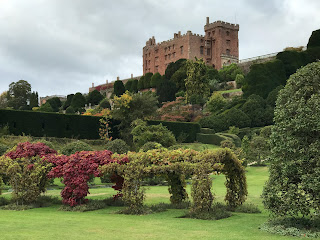In the early Middle Ages, the major Welsh princes and their English neighbours were like the proverbial cats in a sack. Nationalism didn’t come into it. In those days it was more a matter of power. The three major Welsh principalities (Gwynedd, Powys, and Deheubarth) spent as much time fighting each other as they did the English, and in the process, Powys made several disastrous decisions. Prince Gwenwynwyn, in an effort to make himself the dominant Welsh prince, organised the various principalities in an attack upon England where he was soundly thrashed in 1198.
In 1208 he was summoned to England by King John, stripped of his princely status, and forced to swear fealty to the English king. Thus weakened, Powys succumbed to Gwynedd which took advantage of its diminished state. (Bit of a tongue-twister coming up) Twenty-five years after the death of Gwenwynwyn and Gwynedd dominance, his son, Gruffudd, succeeded him with the support of Henry III. Showing a lack of gratitude and good judgement, Gruffudd sided with Gwynedd and Simon de Montford against Henry III, and then a few years later attacked his new overlord, Llywelyn ap Gruffudd of Gwynedd. Llywelyn burnt Powys castle to the ground, and Gruffudd fled seeking the protection of the new English King, Edward I.
In 1282, following Edward’s conquest of Wales and the death of Llywelyn, Gruffudd was restored to his lands. From that time on, his successors prevailed over quarrelsome family members and neighbours by siding four square with the English and in time joined the ranks of the powerful Marcher Lords.
The exterior photographs are mine. Note the changeable Welsh weather. Interior photographs were forbidden so these are scavenged from the internet and a book I actually paid for. Unbelievable.
The castle has changed over the years, its unusual shape dictated by the peculiarly narrow formation of the sandstone on which it stands. Instead of the more usual concentric pattern, Powis is more an impregnable jumble perched on a formidable rock.
Sir Edward Herbert was responsible for the Long Gallery
The state bedroom reserved for visiting monarchs. Puts our guest bedroom to shame.
The ceiling over the Grand Staircase
The Grand Staircase
The Dining Room
Civil War and Restoration
During the Civil War Edward’s son and heir, Sir William Herbert suffered for his loyalty to the king. Parliamentary forces seized the castle, destroyed its defences, and requisitioned everything of value. Sir William, 82 years old and a broken man was reduced to living on £4 a week in lodgings in London. Powis Castle in the meantime was run by the perhaps more democratic Welshpool Committee.
After the Restoration, Sir William’s grandson, another William, was created Earl of Powis by a grateful Charles II but when the king’s brother, James II succeed him Herbert’s luck changed. James, an open Catholic, was driven from the country and the Earl of Powis followed him, Herbert loyalty trumping self-interest.
Corrupted by exile and poverty, the family lost themselves in reckless speculation, penury and pointless quarrels. When the 3rd Marquess, another William, was eventually restored to Powis in 1745 he promptly turned to drink and died three years later. He in turn was succeeded by his Protestant ninth cousin.
The Clive Connection
Henry Arthur Herbert was a loyal Hanoverian, and a grateful George II revived the Powis peerage and made him the first (restored) Earl of Powis. Heavily in debt, the new Earl was forced to sell one of his manors, Oakley Park, to a new national hero: Robert Clive (Clive of India.) It was the beginning of a momentous connection.
When the earl died, castle and estate went to his seventeen-year-old heir, George, the second Earl of Powis, and, when he in turn died some years later, his sister Henrietta succeeded—or more accurately her husband did: Sir Edward, son of the famous Robert Clive (Lord Clive of Plassey who had bought Oakley Farm Manor all those years ago.) Their child, another Edward, assumed the Herbert name out of respect, a small price to pay for a castle.
The formidable Henrietta, Countess of Powis as painted by Joshua Reynolds. The hat was a much later addition to the original portrait which she insisted on as fashions changed.
After her husband’s spectacular victory over Tipu Sultan, Henrietta Countess of Powis travelled through the newly conquered Mysore with 14 elephants 2 camels and 750 attendants and soldiers travelling over a thousand miles with her two daughters and their governess. I think she deserved a new hat.
Clive wealth and astute management saw Herbert fortunes restored and what we have now is an architectural jewel in terms of history and accumulated treasure.
*Powys is the Welsh name of the county. Powis is the Anglicised name of the castle and the earldom.

.jpeg)


























2 comments:
re: Puts our guest bedroom to shame.
And here I thought every Englishman had guest bedrooms like that. Ha!
Should you ever come to stay, the keyton State bedroom is yours — along with a visit to Powis Castle
Post a Comment